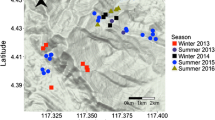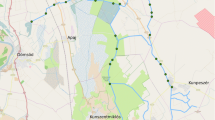Abstract
Studies on the pattern of geographic variation in bird vocalizations can facilitate the understanding of the evolutionary history of species and species differentiation. The Common Cuckoo (Cuculus canorus) is a non-passerine widely distributed in Eurasia, and its calls are not acquired through learning. Revealing the geographic pattern of Common Cuckoo calls may help our understanding of the relationship between environment, genetic differentiation, and vocal differentiation. In the present study, geographic variation in the calls of the Common Cuckoo was investigated throughout Eurasia for the first time. Calls of different subspecies of the Common Cuckoo were compared, and the correlations between differences in calls, geographic distance, climatic differences, and altitude differences were determined in order to evaluate the influence of subspecies differentiation, isolation by distance and environmental differences on call differentiation. The results showed there to be significant differences in the calls of different subspecies of the Common Cuckoo. Discriminant function analysis was able to correctly identify 81.7 % of individuals to their original subspecies, and 98 % of individuals of subspecies subtelephonus were correctly assigned. Differences in calls both within and between subspecies were found to be significantly correlated with geographic distance, while environmental differences have no important effect. Our study stressed the effect of isolation by distance on geographic variation of non-passerine vocalization, and we infer that the great divergence in calls between different Common Cuckoo subspecies may be a hint of cryptic species.
Zusammenfassung
Geographische Variation in den Rufen des Kuckucks ( Cuculus canorus ): Isolation durch Entfernung und Unterschiede zwischen Unterarten
Studien über die geographischen Verteilungsmuster von Lautäußerungen der Vögel können das Verständnis der evolutionären Geschichte von Arten erleichtern. Der Kuckuck (Cuculus canorus) ist ein in Eurasien weit verbreiteter Nichtsperlingsvogel, dessen Rufe nicht erlernt werden. Die geographische Verteilung der Kuckucksrufe darzustellen könnte helfen den Zusammenhang zwischen Umwelt, genetischer Differenzierung und stimmlicher Differenzierung zu verdeutlichen. In dieser Studie wurden erstmals die geographischen Unterschiede zwischen den Rufen des Kuckucks in Eurasien untersucht. Die Rufe verschiedener Unterarten wurden verglichen und die Korrelationen zwischen Unterschieden im Ruf, geographischer Entfernung, klimatischer Unterschiede und Höhenunterschieden berechnet, um die Einflüsse von Unterartendifferenzierung, Isolation durch Entfernung und Umweltfaktoren auf Rufe zu ermitteln. Es zeigten sich signifikante Unterschiede in den Rufen verschiedener Unterarten des Kuckucks. Eine Diskriminanzanalyse war in der Lage, 81,7 % der Individuen ihrer Unterart richtig zuzuordnen und 98 % der Individuen der Unterart subtelephonus wurden richtig zugeordnet. Unterschiede in Rufen sowohl in derselben Unterart als auch zwischen Unterarten waren signifikant mit der geographischen Entfernung korreliert, während Umweltfaktoren keinen Einfluss hatten. Unsere Studie betont den Effekt der Isolation durch Entfernung auf die geographischen Unterschiede in den Lautäußerungen von Nichtsperlingsvögeln und wir schließen aus der großen Variation in Rufen zwischen verschiedenen Unterarten des Kuckucks, dass es sich um eine kryptische Art handeln könnte.




Similar content being viewed by others
References
Ayé R, Schweizer M, Roth T (2012) Birds of Central Asia: Kazakhstan, Turkmenistan, Uzbekistan, Kyrgyzstan, Tajikistan, and Afghanistan. Princeton University Press, Princeton
Catchpole CK, Slater PJB (2008) Bird Song: biological themes and variations, 2nd edn. Cambridge University Press, Cambridge
Dingle C, Halfwerk W, Slabbekoorn H (2008) Habitat-dependent song divergence at subspecies level in the grey-breasted wood-wren. J Evol Biol 21:1079–1089
Fossøy F, Antonov A, Moksnes A, Røskaft E, Vikan JR, Møller AP, Shykoff JA, Stokke BG (2011) Genetic differentiation among sympatric cuckoo host races: males matter. Proc R Soc Lond B 278:1639–1645
Fuisz TI, de Kort SR (2007) Habitat-dependent call divergence in the common cuckoo: is it a potential signal for assortative mating? Proc R Soc Lond B 274:2093–2097
Furrer R, Nychka D, Sain S (2010) Fields: tools for spatial data. http://cran.r-project.org/package=fields
Gibbs HL, Sorenson MD, Marchetti K, Brooke M de L, Davies NB, Nakamura H (2000) Genetic evidence for female host-specific races of the common cuckoo. Nature 407:183–186
Hijmans RJ, Cameron SE, Parra JL, Jones PG, Jarvis A (2005) Very high resolution interpolated climate surfaces for global land areas. Int J Clim 25:1965–1978
Irwin DE (2000) Song variation in an avian ring species. Evolution 54:998–1010
Irwin DE, Thimgan MP, Irwin JH (2008) Call divergence is correlated with geographic and genetic distance in greenish warblers (Phylloscopus trochiloides): a strong role for stochasticity in signal evolution? J Evol Biol 21:435–448
Jung W-J, Lee J-W, Yoo J-C (2014) “cu-coo”: Can you recognize my stepparents?: a study of host-specific male call divergence in the common cuckoo. PLoS ONE 9:e90468
Koetz AH, Westcott DA, Congdon BC (2007) Geographical variation in song frequency and structure: the effects of vicariant isolation, habitat type and body size. Anim Behav 74:1573–1583
Lei F, Zhao H, Wang A, Yin Z, Payne RB (2005) Vocalizations of the common cuckoo Cuculus canorus in China. Acta Zool Sin 51:31–37
Lovell SF, Lein MR (2013) Geographical variation in songs of a suboscine Passerine, the alder flycatcher (Empidonax alnorum). Wilson J Ornithol 125:15–23
MacKinnon J, Phillipps K (1999) A field guide to the birds of China. Oxford University Press, Oxford
Marler P, Slabbekoorn H (2004) Nature’s music: the science of birdsong. Elsevier, San Diego
Morton ES (1975) Ecological sources of selection on avian sounds. Am Nat 109:17–34
Oksanen J, Kindt R, Legendre P, O’Hara B, Stevens MHH, Oksanen MJ, Suggests M (2007) The vegan package. Community Ecology Package
Parker KA, Anderson MJ, Jenkins PF, Brunton DH (2012) The effects of translocation-induced isolation and fragmentation on the cultural evolution of bird song. Ecol Lett 15:778–785
Payne RB (2005) The cuckoos. Oxford University Press, Oxford
Pérez-Mena EE, Mora EC (2011) Geographic song variation in the non-passerine Cuban tody (Todus multicolor). Wilson J Ornithol 123:76–84
R Core Team (2013) R: a language and environment for statistical computing. R Foundation for Statistical Computing, Vienna, Austria. http://www.R-project.org/
Rivera-Gutierrez HF, Matthysen E, Adriaensen F, Slabbekoorn H (2010) Repertoire sharing and song similarity between great tit males decline with distance between forest fragments. Ethology 116:951–960
Robin VV, Katti M, Purushotham C, Sancheti A, Sinha A (2011) Singing in the sky: song variation in an endemic bird on the sky islands of southern India. Anim Behav 82:513–520
Sosa-López JR, Mennill DJ, Navarro-Sigüenza AG (2013) Geographic variation and the evolution of song in Mesoamerican rufous-naped wrens Campylorhynchus rufinucha. J Avian Biol 44:027–038
Teuschl Y, Taborsky B, Taborsky M (1998) How do cuckoos find their hosts? The role of habitat imprinting. Anim Behav 56:1425–1433
Turcokova L, Osiejuk TS, Pavel V, Glapan J, Petrusková T (2010) Song divergence of two bluethroat subspecies (Luscinia s. svecica and cyanecula). Ornis Fenn 87:168–179
Wright S (1943) Isolation by distance. Genetics 28:114
Xing X, Alström P, Yang X, Lei F (2013) Recent northward range expansion promotes song evolution in a passerine bird, the light-vented bulbul. J Evol Biol 26:867–877
Acknowledgments
We would like to thank Prof. Franz Bairlein and two anonymous reviewers who provided helpful comments, which helped us greatly improve this manuscript. The recordists from www.xeno-canto.org and www.avocet.zoology.msu.edu used in this study were much appreciated. We thank Kuankuoshui, Dongzhai and Zhalong National Nature Reserves for support and permission to carry out this study, Longwu Wang, Tongping Su, Juan Huo for assistance with fieldwork, Yajing Chang for assistance with climate data extraction, and Jiangqiang Li, Xiaofeng Zhang for offering four of their recordings. This work was funded by the National Natural Science Foundation of China (Nos. 31272328 and 31472013 to WL, 31172098 to YZ and 31272300 to CJ).
Ethical standard
The experiments comply with the current laws of China in which they were performed.
Author information
Authors and Affiliations
Corresponding author
Additional information
Communicated by F. Bairlein.
Electronic supplementary material
Below is the link to the electronic supplementary material.
Rights and permissions
About this article
Cite this article
Wei, C., Jia, C., Dong, L. et al. Geographic variation in the calls of the Common Cuckoo (Cuculus canorus): isolation by distance and divergence among subspecies. J Ornithol 156, 533–542 (2015). https://doi.org/10.1007/s10336-014-1153-6
Received:
Revised:
Accepted:
Published:
Issue Date:
DOI: https://doi.org/10.1007/s10336-014-1153-6




